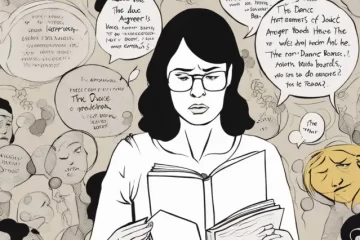Enhancing Mental Health Awareness: Why Naoki Higashida’s The Reason I Jump is a Must-Read


In an increasingly complex and interconnected world, the subject of mental health has become a matter of critical concern. Hidden behind societal stigmas and misperceptions, individuals with neurodevelopmental disorders often struggle to communicate their experiences. However, Naoki Higashida, a Japanese author diagnosed with autism, challenges these limitations in his groundbreaking book, “The Reason I Jump.” Through Higashida’s unique and poignant perspective, this article delves into the depths of mental health, urging society to not only listen but also understand the lived realities of those who navigate the enigmatic labyrinth of their minds.
What is Mental Health
Mental health refers to a person’s emotional, psychological, and social well-being. It affects how individuals think, feel, and act. Mental health encompasses various aspects such as one’s ability to handle stress, make decisions, and form relationships. Good mental health is important for overall well-being and can positively impact physical health, work productivity, and relationships. Mental health can be influenced by various factors, including genetics, environmental factors, life experiences, and family history of mental health problems. Mental health issues can range from mild to severe conditions such as anxiety disorders, depression, bipolar disorder, schizophrenia, and substance abuse disorders. It is important to prioritize and maintain good mental health through self-care practices, seeking support when needed, and accessing appropriate treatment options.
Why is Mental Health Important to Us
Mental health is important to us because it affects our overall well-being and quality of life. Here are some key reasons why mental health is important:
1. Emotional well-being: Mental health directly impacts our emotions and ability to cope with daily stressors. It influences how we perceive and handle our emotions, allowing us to experience more positive emotions and effectively manage negative ones.
2. Physical health: Mental health and physical health are closely interrelated. Good mental health promotes better physical health outcomes, including lower risk of chronic diseases, improved immune system functioning, better sleep patterns, and increased energy levels.
3. Relationships: Mental health affects our ability to build and maintain healthy relationships. When we have good mental health, we tend to have better communication skills, empathy, and stronger connections with others.
4. Personal growth and productivity: A positive mental state fosters personal growth, resilience, and motivation. It allows us to set and achieve goals, work towards personal development, and pursue our passions. Good mental health also enhances productivity and performance in various aspects of life, such as academics, work, and hobbies.
5. Daily functioning: Mental health plays a crucial role in our ability to carry out daily tasks effectively and enjoy a meaningful life. It affects our concentration, memory, decision-making, problem-solving, and overall cognitive functioning.
6. Reduced risk of mental disorders: Prioritizing mental health can act as a preventive measure against the development of mental disorders. By promoting positive mental health, we can decrease the likelihood of experiencing conditions such as anxiety disorders, depression, and other mental illnesses.
7. Overall life satisfaction: Good mental health contributes significantly to our overall life satisfaction and happiness. It allows us to experience a sense of fulfillment, purpose, and enjoyment in life.
It is important to invest in our mental health by engaging in self-care practices, seeking support when needed, and promoting mental health awareness within our communities.
Unlocking Mental Health from The Reason I Jump

The Reason I Jump Introduction
The Reason I Jump is a memoir written by Naoki Higashida, a nonverbal autistic boy from Japan. The book provides readers with a unique insight into Naoki’s inner world, offering a glimpse into the often misunderstood experience of living with autism. Through a series of questions and answers, Naoki shares his thoughts, feelings, and observations about his daily life, giving readers a deeper understanding of the challenges he faces in communication and social interactions. He explores subjects such as sensory sensitivity, repetitive behaviors, and the difficulties in relating to others. Naoki’s writing conveys a profound sense of empathy, allowing readers to appreciate the complexity and depth of his emotions. Overall, “The Reason I Jump” offers a moving and enlightening perspective on autism, encouraging greater understanding and acceptance of individuals on the spectrum.
Learning Mental Health Methods
In “The Reason I Jump” by Naoki Higashida, the author’s primary focus is on explaining his experience with autism rather than providing specific mental health methods. However, the book does touch upon some strategies or perspectives that may be helpful for individuals with autism or other mental health challenges. Here are a few key ideas related to mental health from the book:
1. Acceptance and Understanding: Higashida emphasizes the importance of acceptance and understanding from others towards individuals with autism. He encourages readers to approach them with empathy rather than judgment.
2. Communicating with Visuals: The author explains that many individuals with autism, including himself, find visual representations helpful for communication. Visual aids like pictures, drawings, or written words can assist in expressing feelings and thoughts.
3. Routines and Predictability: Higashida highlights the significance of maintaining routines and having predictable environments for individuals with autism. This stability can help reduce anxiety and promote a sense of control.
4. Sensory Overload: The book mentions the sensory challenges that people with autism can face. Understanding and accommodating these sensitivities, such as creating calm and quiet spaces or using earplugs/headphones, can help manage sensory overload.
5. Building Connections: Higashida expresses a desire for social connection and fulfilling relationships. Engaging with individuals with autism in meaningful ways and creating inclusive environments can contribute positively to their mental well-being.
It is important to note that “The Reason I Jump” provides insights specific to the author’s experience with autism and may not directly address mental health methods applicable to all individuals. For a more comprehensive understanding of mental health strategies and approaches, consulting with a mental health professional or referring to evidence-based resources is recommended.
The Reason I Jump Quotes
The Reason I Jump quotes as follows:
1. “Even if we’re non-verbal, we have our own way of expressing ourselves.”
2. “Whenever you see someone with a disability, never lea to conclusions about what that person can or cannot do based on your preconceptions.”
3. “It’s funny, isn’t it? When people ask us questions, they’re really just trying to connect.”
4. “We might look like a group of people without options, but we actually have more choices than you know.”
5. “I’m not sure if you know this, but when we want to go somewhere or do something, we have to ask for assistance, and that makes us hesitant to try new things.”
6. “Our minds are always moving and creative, even if our bodies are not.”
7. “Just because we can’t speak doesn’t mean we don’t have anything to say.”
8. “We get frustrated easily because we can’t tell others what we need or want.”
9. “In spite of everything, I still believe that people are truly good at heart.”
10. “By learning to view the world from a different perspective, we can develop a deeper understanding and empathy for others.”

More Books About The Reason I Jump by Naoki Higashida
1. Thinking, Fast and Slow by Daniel Kahneman: This book explores the psychology behind our thought processes and decision-making. Similar to “The Reason I Jump”, it delves into the workings of the mind and the biases that can influence our perceptions.
2. “The Curious Incident of the Dog in the Night-Time” by Mark Haddon: Although not directly related to autism, this novel offers a unique perspective on the mind of someone with different neurocognitive abilities. It shares similarities with “The Reason I Jump” in its exploration of the inner world and challenges of communication.
3. “Neurotribes: The Legacy of Autism and the Future of Neurodiversity” by Steve Silberman: This enlightening and well-researched book provides a historical account of autism, debunking misconceptions and emphasizing the importance of embracing neurodiversity. It complements the themes discussed in “The Reason I Jump”.
4. “Autism Breakthrough: The Groundbreaking Method That Has Helped Families All Over the World” by Raun K. Kaufman: This book presents an alternative approach to autism treatment, promoting a methodology known as the Son-Rise Program. By sharing the experiences and success stories of families, it offers hope and practical guidance beyond Naoki Higashida’s personal account.
5. “Uniquely Human: A Different Way of Seeing Autism” by Barry M. Prizant: Dr. Prizant, an experienced autism specialist, challenges common misconceptions surrounding autism. Focusing on the importance of understanding and meaningful connections, this book provides a fresh perspective on autism that aligns with the empathetic approach found in “The Reason I Jump”.
These five book recommendations cover various aspects related to autism, neurodiversity, and understanding the unique experiences of individuals with different cognitive abilities. They delve into the mind, societal perceptions, and alternate methods for nurturing and supporting neurodivergent individuals, complementing the themes explored in “The Reason I Jump”.


0 Comments